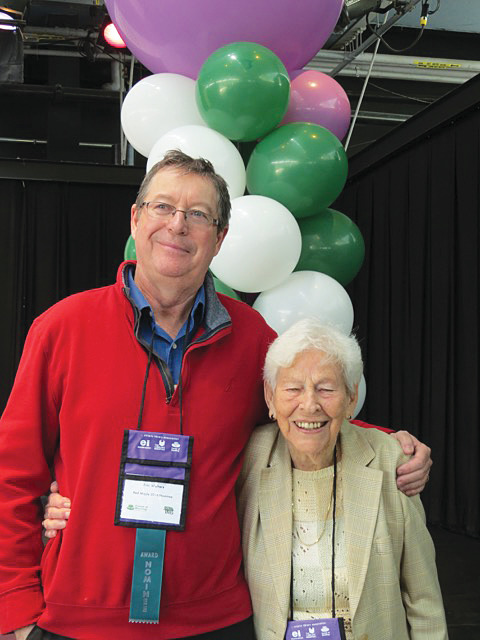Can Write: Meeting Canadian Writers and Illustrators of Children’s Books
What inspires the writers of the books your students read? How does an illustrator decide what to draw? Is it true that most authors and illustrators don’t know each other? This column features a different Canadian children’s book creator in each issue and shows you the story beyond the covers.
Eric Walters is one of the most hard working authors I know. With more than 100 books to his name – many award winning – he speaks full time in schools. I asked him some questions.
Margriet: You were a teacher but successfully made the leap to becoming a writer. How did that happen?

Eric Walters and his elementary school teacher.
Eric: I started writing for my class. They didn’t like to read or write, but were very good at making up stories – usually to avoid another suspension. I set the first book in that school and, with permission, made some of them characters in my book. I read it to them chapter by chapter. At the end of the story one of the kids said, “You know, Mr. Walters, your book isn’t as bad as some in the library. Why don’t you try to have it published?” This was a huge compliment from that group. I sent it off to six publishers, five rejected it but one accepted it. Now I had written a book, but I wasn’t a writer. I was a teacher. At the start of the next school year the students asked, “What are you going to write about this year?” Apparently I was a writer! I wrote my first 25 novels while working as a teacher. I wrote books that fit into the curriculum I was teaching. I was in the wonderful position that I could see, day by day, what worked and what didn’t. It’s a fact that teachers know what students read and like. I always joke that prior to my first novel coming out, my only “fictional writing” was report cards. Teachers are often good writers. If you look at the history of writers you’ll see that many started as teachers. While I loved teaching – and still consider myself a teacher – it became time for me to pursue writing on a full time basis. I’ve now been out of the class for twelve years, writing and presenting to over 1.8 million students.
Margriet: You have written over a hundred books in 23 years. Tell us about your “getting an idea” and writing process.
Eric: Ideas come from everywhere, all the time. My ears and eyes are always open. I am a “plotter.” I follow the advice I always gave my students: do a story map, figure out the story, have an outline of your characters. Not that I necessarily follow that plan. I follow leads, go in unexpected directions, allow the story to take flight. I have an idea where the story is going, even if I end up taking a detour. As much as I’m a plotter I am a researcher. I interview experts, view videos, read background books, go on YouTube and actually do the things my characters do. For Just Deserts I walked across the Sahara Desert, for Between Heaven and Earth I climbed Mount Kilimanjaro, for Walking Home I walked 200 kilometres across Kenya following the route my characters traveled. For Run I ran marathons in provinces where Terry Fox ran. I want to feel the story not just in my head but in my heart and in the bottoms of my feet. I also often use a test audience – a class or school that takes the place of my original audience, my class. They provide feedback that shapes the story.
Margriet: Recently you branched out from novels to picture books. How is this writing process different and do you prefer one over the other?
Eric: I’m still most comfortable writing novels. Give me 75,000 words and I can make sense of a situation. Picture books are more precise. Thank goodness I’ve had wonderful illustrators and incredible editors who have guided me in my education as a picture book person. I write different types of books in the different genres. Change refreshes your creative pallet. I’ve now written everything from board books (coming out next year) to high school Y.A.
Margriet: You speak in schools daily. How do you feel that writing and speaking support each other, both for you and for your readers?
Eric: I call myself a literacy evangelist. I speak to over 75,000 students, teachers and parents each year. I have a dozen presentations all focused on different age groups and with different central themes. I want to talk about more than just my books. I talk about humanitarian efforts, civil rights, literacy, boys’ literacy, the role of teachers in promoting reading and writing, and the essence of what makes Canada the greatest country on earth. I use slide shows, power point, videos, and do experiential things to get them involved. I love when kids – especially those hard to please grade 7 and 8 boys – stay after a presentation to talk, want to sit in for a second session, and tell me how much it meant to them.
Margriet: You founded an orphanage in Kenya. What brought this about and how is it tied to your books?
 Eric: The Creation of Hope was co-founded and co-run by my wife and me and a family in Kenya: Ruth and Henry Kyatha. We have 66 orphans in our residence, 69 children in residential high school, college or university, and another 150 orphans or impoverished children in guardian homes. We also have done water projects, and provided uniforms, livestock and supplies in the community. We have sponsors but also widespread school support. Last year we had over 100 schools involved across the continent and internationally. We promise schools that 100% of donations from schools and students go directly to service and then we show them dollar by dollar, school by school, item by item, how their money is used. If a student gives me $7 for a blanket they will receive a picture of the child with the blanket and a personal thank you. We try to create global citizens. My picture books The Matatu, My Name is Blessing, Hope Springs and Today Is The Day, were inspired by real events in Kenya. The books inspire people but also have been an encouragement to get involved and donate money to help our orphans. Interestingly my own inspiration often comes from young people who react to the stories and get involved. There is something amazing about a ten-year-old walking up and pressing 75 cents into my hands and saying “this is to help the orphans.” I always take down the donor’s name, and the email address of the teacher/librarian so that this young person can get a thank you sign to let them know that their donation makes a difference.
Eric: The Creation of Hope was co-founded and co-run by my wife and me and a family in Kenya: Ruth and Henry Kyatha. We have 66 orphans in our residence, 69 children in residential high school, college or university, and another 150 orphans or impoverished children in guardian homes. We also have done water projects, and provided uniforms, livestock and supplies in the community. We have sponsors but also widespread school support. Last year we had over 100 schools involved across the continent and internationally. We promise schools that 100% of donations from schools and students go directly to service and then we show them dollar by dollar, school by school, item by item, how their money is used. If a student gives me $7 for a blanket they will receive a picture of the child with the blanket and a personal thank you. We try to create global citizens. My picture books The Matatu, My Name is Blessing, Hope Springs and Today Is The Day, were inspired by real events in Kenya. The books inspire people but also have been an encouragement to get involved and donate money to help our orphans. Interestingly my own inspiration often comes from young people who react to the stories and get involved. There is something amazing about a ten-year-old walking up and pressing 75 cents into my hands and saying “this is to help the orphans.” I always take down the donor’s name, and the email address of the teacher/librarian so that this young person can get a thank you sign to let them know that their donation makes a difference.
Margriet: Your very successful Seven Series includes a wide variety of other authors. What made you think of this project and how is it different from writing your own series?
Eric: I like working with other writers. Writers are generally nice people. Organizing them can be a little more challenging… The third instalment of the Seven Series is coming out, the prequels to the original stories. We’re going on a massive tour together to promote those books. Then The Fourth Dimension, next in the Rule of Three trilogy comes out. After that …well, I’ve still got an idea or two.
For more details, check out:
ericwalters.net • ericwalterswalkinghome.com • creationofhope.com
ABOUT THE AUTHOR
Margriet Ruurs
Margriet Ruurs is the author of 28 books for children. She conducts author presentations in schools around the country. margrietruurs.com










